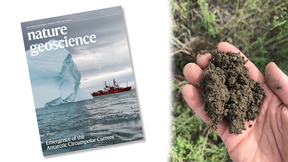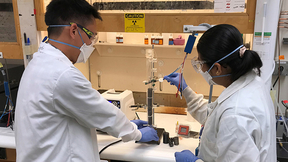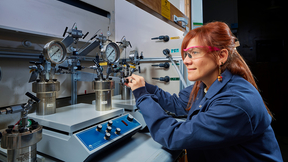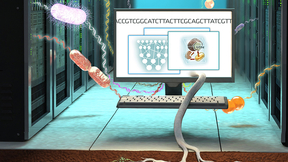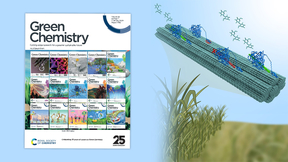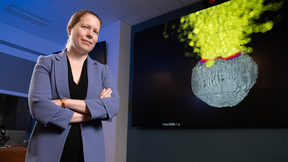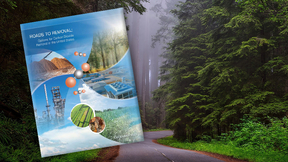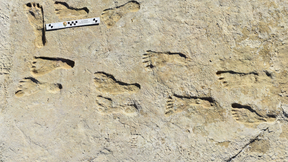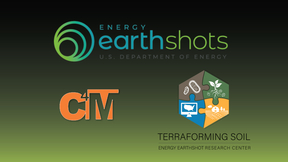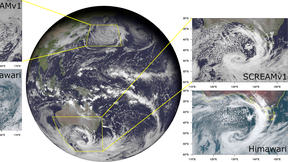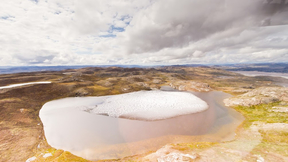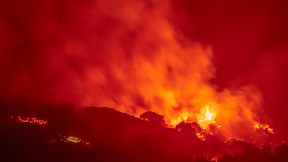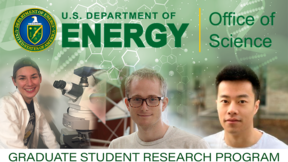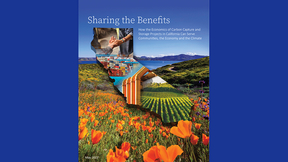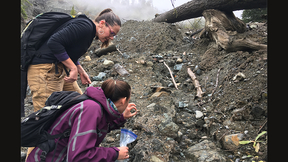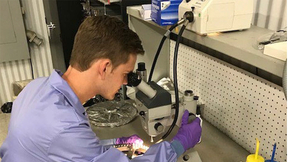Back
Particulate soil carbon may be more vulnerable to microbial decomposition under warmer temperatures associated with climate change. Soil organic matter contains more carbon than plants and the atmosphere combined. Soil is increasingly considered for its potential role in climate mitigation due to its ability to sequester more carbon, but it also is critical to understand…
Four Lawrence Livermore National Laboratory (LLNL) researchers have partnered with Los Angeles-based SoCalGas and Munich, Germany-based Electrochaea to develop an electrobioreactor to allow excess renewable electricity from wind and solar sources to be stored in chemical bonds as renewable natural gas. When renewable electricity supply exceeds demand, electric-utility…
Lawrence Livermore National Laboratory (LLNL) has received $1 million to explore technologies that stimulate hydrogen production from mineral deposits found in the subsurface, including developing our understanding of hydrogen-producing geochemical reactions and how to enhance or control the rate of hydrogen production. The use of hydrogen fuel to offset fossil fuel…
Microbes are major drivers of carbon and nutrient fluxes in Earth’s terrestrial ecosystems; however, Earth system models used for climate change adaptation and mitigation strategies typically exclude explicit representation of soil microorganisms. A team of researchers from Lawrence Livermore National Laboratory (LLNL), Lawrence Berkeley National Laboratory (LBL) and…
A Lawrence Livermore National Laboratory (LLNL) scientist is part of a research team shedding new light on how to access the sugars locked up in plant materials in order to convert byproducts into new feedstocks for production of fuels, materials and chemicals. Converting grasses, weeds, wood and other plant residues into sustainable products normally produced using…
Researchers at Lawrence Livermore National Laboratory (LLNL) have developed a modeling tool for assessing the potential use of a nuclear device to defend the planet against catastrophic asteroid impacts. The research, published today in the Planetary Science Journal, introduces a novel approach to simulating the energy deposition from a nuclear device on an asteroid's…
Lawrence Livermore National Laboratory (LLNL) researchers, along with scientists from more than a dozen institutions, have completed a first-of-its-kind high-resolution assessment of carbon dioxide (CO2) removal (CDR) in the United States. The report, “Roads to Removal: Options for Carbon Dioxide Removal in the United States,” charts a path for the United States to achieve…
In 2022, Americans used more renewables to generate electricity than in previous years, according to the most recent energy flowcharts and carbon flowcharts released by Lawrence Livermore National Laboratory (LLNL). The nation used 3% more energy, emitted an additional 96 million tons of CO2, but decreased the carbon intensity of U.S. electricity generation by 3.6%,…
New research reaffirms that human footprints found in White Sands National Park, New Mexico, date to the Last Glacial Maximum, placing humans in North America thousands of years earlier than once thought. In September 2021, U.S. Geological Survey researchers and an international team of scientists announced that ancient human footprints discovered in White Sands National…
On Thursday, August 24, a dozen LLNL postdocs presented in the annual Postdoctoral Research Slam, answering the question “Why is my research important?” in only three minutes. Each talk was then evaluated by LLNL leadership, awarding first and second place to PLS postdocs Brandon Zimmerman and Aditya Prajapati, respectively. As a bonus, the attending audience voted on…
Lawrence Livermore National Laboratory (LLNL) scientists will lead and co-lead projects in support of the Department of Energy’s (DOE) new Energy Earthshot program. The Energy Earthshots Initiative calls for innovation and collaboration to tackle the toughest topics in energy-related research. In January, DOE announced Office of Science funding for the Energy Earthshot…
A team from Lawrence Livermore National Laboratory (LLNL) and seven other Department of Energy (DOE) national laboratories is a finalist for the new Association for Computing Machinery (ACM) Gordon Bell Prize for Climate Modeling for running an unprecedented high-resolution global atmosphere model on the world’s first exascale supercomputer. The Gordon Bell submission, led…
When SpaceX’s Dragon spacecraft docked with the International Space Station (ISS) on March 16, it delivered several thousand pounds of supplies for the crew as well as new hardware. The hardware included the U.S. Space Force’s Space Test Program Houston 9 (STP-H9) platform, which houses a prototype telescope designed and built by Lawrence Livermore National Laboratory's…
A large portion of Greenland was an ice-free tundra landscape — perhaps covered by trees and roaming wooly mammoths — in the recent geologic past (about 416,000 years ago), according to a new study in the journal Science. The results shed light on the stability of the Greenland ice sheet, which was long assumed to have been frozen continuously over the last two and a half…
Summer wildfire seasons in California routinely break records. The average summer burn area in forests in northern and central portions of the state have increased fivefold between 1996 and 2021 compared to between 1971 and 1995. Although the drivers of increased temperature and dryness are known, the contribution of human-caused climate change to wildfire activity,…
Three graduate students have earned Department of Energy Office of Science Graduate Student Research (SCGSR) Program awards to perform their doctoral dissertation research at Lawrence Livermore National Laboratory (LLNL). They are three among the 87 graduate students representing 33 states for the SCGSR program’s 2022 Solicitation 2 cycle. Through world-class training and…
A new report co-authored by George Peridas of the Lawrence Livermore National Laboratory (LLNL) and Benjamin Grove of the Clean Air Task Force examines the economic viability of carbon capture and storage (CCS) projects in California and finds that several classes of projects are viable today. These can help the state meet its climate goals and hold a sizable potential to…
New research shows that it is now virtually impossible for natural causes to explain satellite-measured changes in the thermal structure of Earth’s atmosphere. The analysis conducted by Lawrence Livermore National Laboratory (LLNL) scientists and colleagues for the first time demonstrates that extending “fingerprinting” techniques — used to identify the human effects on…
Carbonate minerals are formed when carbon dioxide reacts with magnesium and calcium-rich rocks. But where does that CO2 come from? If it comes from the atmosphere, this process at sufficient scale may be able to reliably draw down atmospheric greenhouse gas levels, according to new research by Lawrence Livermore National Laboratory (LLNL) scientists. The research appears…
The dangers of coastal erosion are an all-too-familiar reality for the modern residents of California’s iconic mountainous coastal communities. With a new tool, researchers are now bringing historical perspective to the topic of how to manage these disappearing coastlines. Using a model that incorporates measurements of the amount of time coastal cliffs and their remnant…

